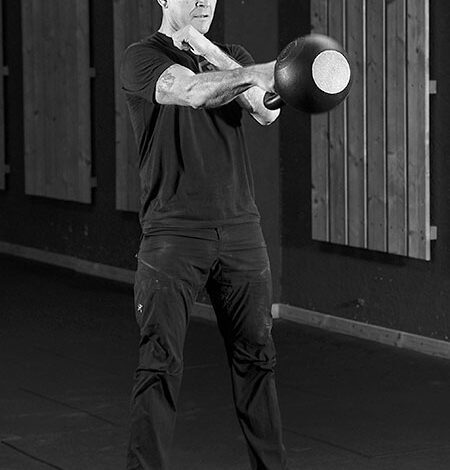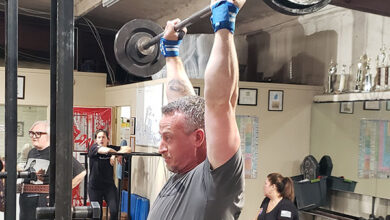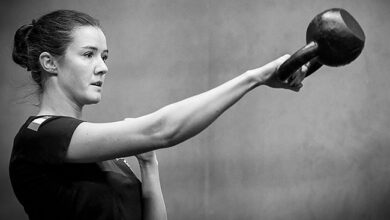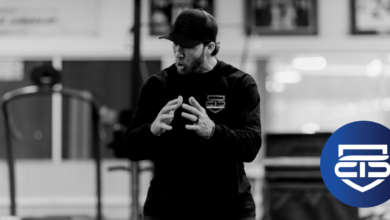The Kur for Your Kettlebell Swing and Clean

It has been stated that the swing is the center of the kettlebell universe, and it is a well-known fact that the kettlebell deadlift is the foundation of the swing.
Every StrongFirst student begins their kettlebell journey with the kettlebell deadlift. By hinging the hips back into an athletic stance with the kettlebell positioned directly under the center of mass, the student grips the handle tightly, packs the shoulders, and drives the hips forward into extension—ultimately forming a vertical “plank” of total body tension.

This movement serves as the detailed foundation of the kettlebell swing. What follows can vary from student to student, based on the instructor’s judgment. However, sooner or later, the dead swing will enter the arena of practice drills designed to solidify and enhance the learning curve of the kettlebell swing.
Seasoned kettlebell athletes and StrongFirst Certified Instructors share a common trait: they regularly return to the foundations of complex movements, such as the kettlebell swing and clean. It is in this return to basics that fundamental skills are practiced and refined to achieve a high level of proficiency.
The StrongFirst blog provides an abundance of articles about the kettlebell swing, such as “The Origins of the Dead Swing,” written by the StrongFirst Certified Master Instructor Emeritus Mark Reifkind, which offers an outstanding source of information specifically on the dead swing.
The German word Kur (pronounced koor) refers to a treatment or therapy, particularly a therapeutic course or a period of treatment designed to restore health. In the context of training—particularly the kettlebell swing and clean—we could think of it as a period of practice designed to restore proficiency.
This dedicated period of specific practice can be administered to athletes starting their kettlebell journey to build skill in the initial stages of the kettlebell swing. Similarly, the same practice period can be used by an experienced kettlebell practitioner to reinforce the basic skills of the movement.

Although the practice itself is identical, its benefits vary: the new student will gain proficiency in performing the exercise, while the instructor will deepen their understanding of the movement, thereby enhancing the quality of their teaching.
Drawing from many sources and my personal experience as both a student and instructor, the tips and training plan that follow are my prescription: the Kur for your kettlebell swing and clean.
Practice tips
Choosing the correct intensity for the practice
At StrongFirst, while the terms “training” and “practice” are sometimes used interchangeably, it is important to understand that the training effect is a byproduct of deliberate practice. Therefore, when selecting a kettlebell weight for practice, it is generally recommended to choose a conservative option—one that enables perfect repetitions—rather than exceeding your current capabilities.
The selected kettlebell, whether for a beginner or an experienced girevik, must not surpass the individual’s ability to control the weight shift during the hike. The hips and upper legs should absorb the kettlebell’s weight while remaining stable, ensuring there is no excessive rising or shifting of the hips.
This stability can be achieved by emphasizing that most of the weight remains over the balls of the feet, which activates tension in the big toes. Allowing the weight to shift to the heels requires one to pull on the kettlebell handle, disrupting this activation. Instead, focusing on forcefully pressing the big toes into the ground throughout the movement will significantly enhance the overall quality of the swing.

This seemingly minor detail, though often overlooked, forms the second step in setting up an effective and powerful swing.
The importance of a proper setup distance
One of my personal pet peeves—gathered from years of practice and working with countless students—is the distance one maintains from the kettlebell during the setup. This (again) often-overlooked aspect plays a critical role in ensuring a proper and efficient swing.
To maintain optimal bodyweight distribution over the balls of the feet and consistent tension in the big toes, standing closer to the kettlebell than most people are used to is essential. Through trial and experience, I’ve found that a distance of roughly one foot-width from the kettlebell works best.

This setup ensures that, when the hike is initiated, the energy from the kettlebell’s weight displacement is fully absorbed by the hips, which remain locked in place and become “loaded.” This lack of unnecessary hip movement prevents energy loss, allowing the hips to drive forward into complete extension. This powerful hip extension then propels the arm(s) and kettlebell forward, resulting in an efficient and horizontal projection of force. The exact principles are used for the one-arm, two-arm, and double kettlebell swing.
The Dead Swing Plan
For optimal results follow the plan for 2 to 4 weeks performing 3 to 5 practice sessions per week.
Abbreviations: one-arm (1A), two-arm (2A), double kettlebell (DBL), dead swing (DSW)
Session #1: Ladders
- Exercise: 1A, 2A, or DBL DSW
- Structure: 1,2,3 ladder on 1:30min
- Repeats: Set an interval timer for 15, 30, and 45 seconds
- Example:
- Start at 00:00 with 1 rep
- At 00:15, perform 2 reps
- At 00:45, perform 3 reps
- Rest until 01:30 before starting the next ladder
- Arm alternation: For 1A DSW, alternate arms after each ladder (left: 1,2,3; right: 1,2,3; etc.)
- Duration: Continue until you are unable to pass the talk test (approximately 20+ minutes) or (if using a heart rate monitor) your heart rate (HR) reaches 80% max heart rate (MHR).
Session #2: Timed sets (Repeats)
- Exercise: 1A, 2A, or DBL DSW
- Structure: 1x DSW on 20 seconds
- Arm alternation: For 1A DSW, alternate arms after each set (left: 1, right: 1, left: 1, right: 1, etc.)
- Duration: Continue until you are unable to pass the talk test (approximately 20+ minutes) or (if using a HR monitor) your HR reaches 80% MHR.
Session #3: Rest-pause sets (Series repeats)
- Exercise: 1A, 2A, or DBL DSW
- Structure: 5 rest-pause reps in one series
- Execution: Begin each series on 1:30min. Perform 1x DSW, stand up briefly, and repeat until 5 reps are completed. Rest ~1:00 minute between series.
- Arm alternation: For 1A DSW, alternate arms each series
- Example:
- Start at 00:00 with left 1,1,1,1,1
- Start at 01:30 with right 1,1,1,1,1
- Rest until 03:00, and repeat
- Example:
- Duration: Continue until you are unable to pass the talk test (approximately 30+ minutes) or (if using a HR monitor) your HR reaches 80% MHR.
Roll a die to determine the type of dead swing to be performed and which session to execute.
Step 1: Dead swing type

Step 2: Session

Dead-Stop Clean
As an added benefit, the dead-stop clean can be performed in the same manner as the dead swing. One of the primary advantages of practicing the dead-stop clean is its ability to enhance power in the snatch.
The deadlift is the foundational movement for the swing, the clean, and the snatch. Since the snatch is essentially a clean that finishes with the weight held overhead, it also traces its origins to the deadlift. The main distinction between the swing and its two closely related exercises lies in the direction of force projection: the swing emphasizes horizontal force, whereas the clean and snatch focus on vertical force.

Due to the clean’s vertical projection of force, its setup closely resembles the one previously described for the swing, but with greater emphasis on keeping the kettlebell close to the center of mass.
Setup for the clean
Begin by standing with your toes close to the kettlebell (approximately one foot-width away from the bell). Hinge back into an athletic stance, with roughly 60% of your bodyweight centered over the balls of your feet. Visualize preparing to jump over a low fence located just ahead of you.

Start the movement by performing a “shallow” hike of the kettlebell, slightly behind the heels of your feet. Press the entire foot firmly into the ground, focusing on the balls of your feet and explosively drive your hips forward into full extension, imagining a vertical jump.
The force generated by your hip extension travels through your torso and into your arm, propelling the kettlebell to float vertically upward toward your midsection. At full hip extension, the elbow retracts backward, followed by the forearm moving upward as the hand spears through the kettlebell handle’s window. From this point, the kettlebell is smoothly guided into the rack position, resting between your upper and lower arm.
Visualize your lower arm and elbow functioning like the piston arms of a steam locomotive—moving vertically instead of horizontally.
The exact principles are used for the single and double kettlebell clean.
The Dead-Stop Clean Plan
For optimal results follow the plan for 2 to 4 weeks performing 3 to 5 practice sessions per week.
Abbreviations: one-arm (1A), double kettlebell (DBL), dead-stop clean (DSCL)
Session #1: Ladders
- Exercise: 1A or DBL DSCL
- Structure: 1,2,3 ladder on 1:30min
- Repeats: Set an interval timer for 15, 30, and 45 seconds
- Example:
- Start at 00:00 with 1 rep
- At 00:15, perform 2 reps
- At 00:45, perform 3 reps
- Rest until 01:30 before starting the next ladder
- Arm alternation: For 1A DSCL, alternate arms after each ladder (left: 1,2,3; right: 1,2,3; etc.)
- Duration: Continue until you are unable to pass the talk test (approximately 20+ minutes) or (if using a HR monitor) your HR reaches 80% MHR.
Session #2: Timed sets (Repeats)
- Exercise: 1A or DBL DSCL
- Structure: 1x DSCL on :20 seconds
- Arm alternation: For 1A DSCL, alternate arms after each set (left: 1, right: 1, left: 1, right: 1, etc.)
- Duration: Continue until you are unable to pass the talk test (approximately 20+ minutes) or (if using a HR monitor) your HR reaches 80% MHR.
Session #3: Rest-pause sets (Series repeats)
- Exercise: 1A or DBL DSCL
- Structure: 5 rest-pause reps in one series
- Execution: Begin each series on 1:30min. Perform1x DSCL, stand up briefly, and repeat until 5 reps are completed, rest ~1:00 minute between series.
- Arm alternation: For 1A DSCL, alternate arms each series
- Example:
- Start at 00:00 with left 1,1,1,1,1
- Start at 01:30 with right 1,1,1,1,1
- Rest until 03:00, and repeat
- Example:
- Duration: Continue until you are unable to pass the talk test (approximately 30+ minutes) or (if using a HR monitor) your HR reaches 80% MHR.
Roll a die to determine the type of dead-stop clean to be performed and which session to execute.
Step 1: Dead-stop clean type

Step 2: Session

Final Thoughts
The kettlebell swing and clean are more than just exercises—they are foundational movements that enhance strength, power, and control in all facets of training. By implementing structured practice plans like the Kur for the dead swing and the dead-stop clean, you can cultivate a deeper understanding of these techniques, whether you’re a beginner or a seasoned instructor.
Consistency, attention to detail, and a return to the basics are key to long-term success. These principles ensure that every rep contributes to better performance, injury prevention, and a refined mastery of the craft. With practice, dedication, and these tools in your arsenal, you can confidently progress in your kettlebell journey while helping others do the same.
Embrace the process, trust the fundamentals, and let the results speak for themselves.
Stay focused and train smart.
Join Pavel Tsatsouline and Fabio Zonin for
PROGRAMMING DEMYSTIFIED, the ultimate seminar for designing
foolproof programs to break plateaus, build muscle, and grow stronger!





